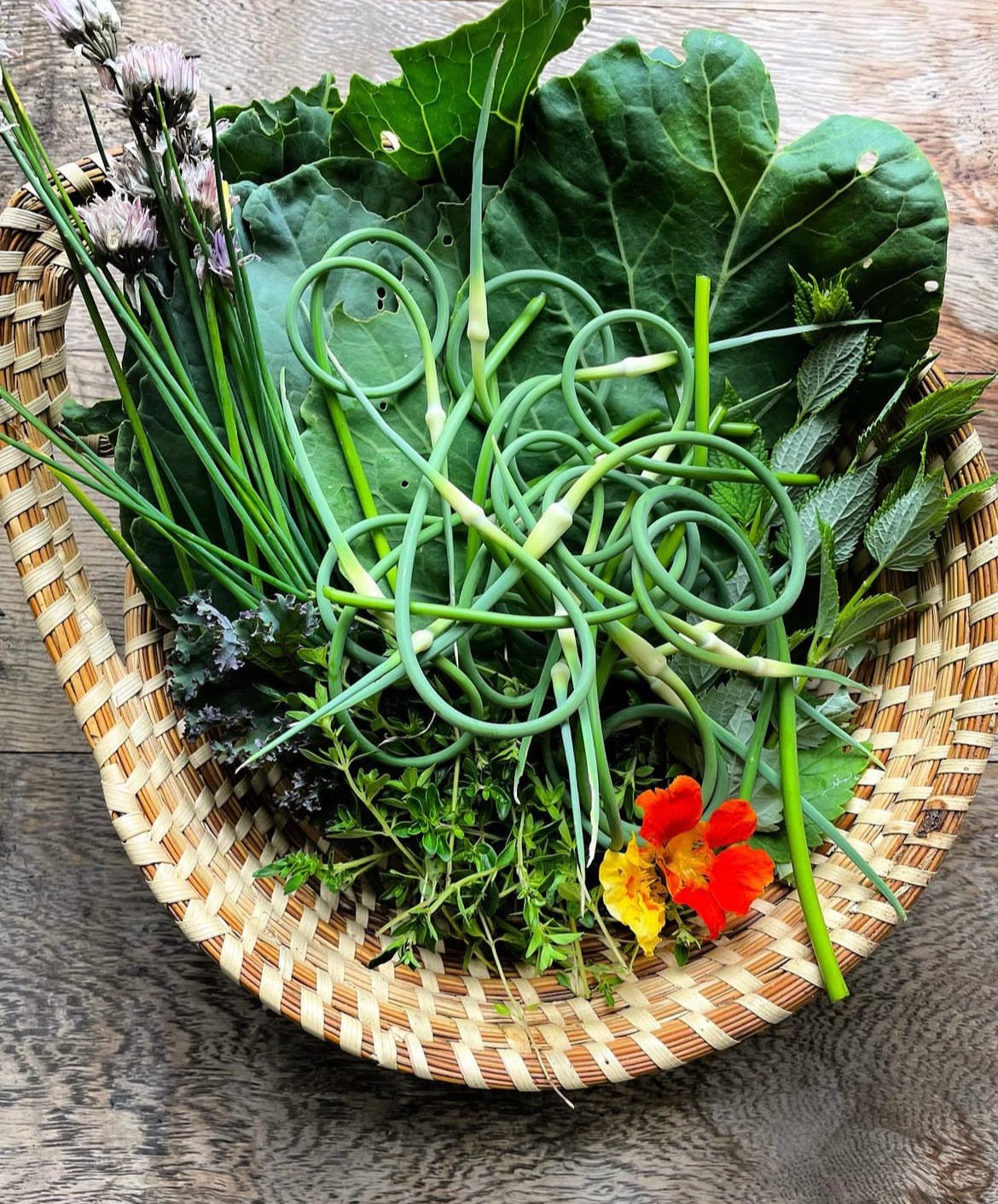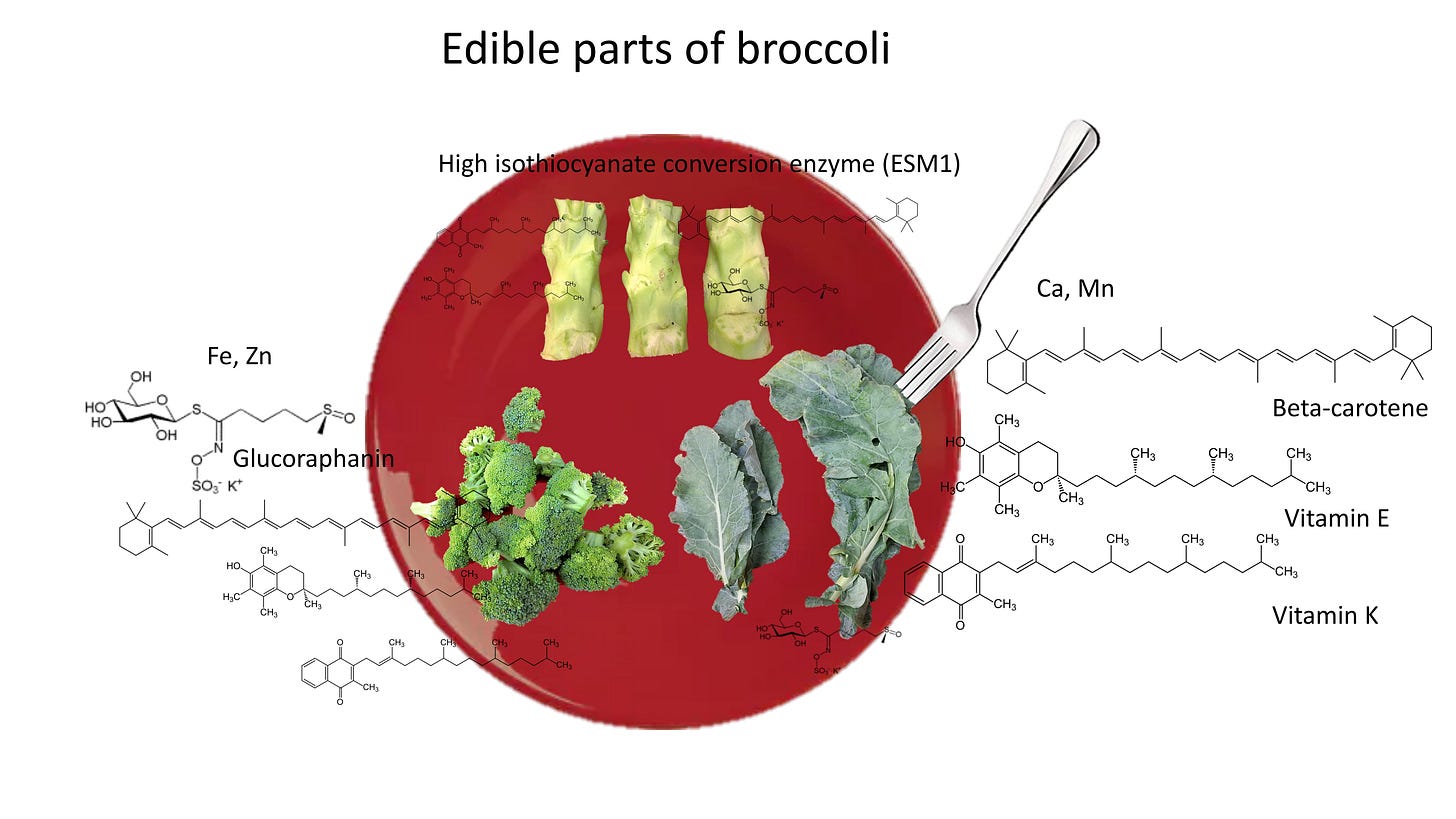May is here, which means garden prep is in full swing. This is a time of potting up, hardening off, and prepping beds for seeding and transplants. The snow melt from our May 1st storm (and ongoing rain) thwarted any efforts in the physical garden this weekend. Nonetheless, there were plenty of indoor garden chores to keep us busy.
We moved our cold hardy plants (brassicas, swiss chard, etc.) from their cozy spot under grow lights to the south facing, unheated sunporch. This will be their new home until transplanting time around Memorial Day weekend. I often wait until at least June 1st to transplant our tender plants as they (and I) have been burned by late season frosts here in zone 5.
This week’s newsletter explores the concept of cooking and eating from the whole plants we grow in our home gardens. This seed-to-stem concept is not new and was often born out of necessity. I’d like to reframe this approach from the perspective of abundance, creativity, and sustainability as opposed to scarcity. As discussed in my Growing Rainbows newsletter, gardening is an incredible tool for increasing dietary diversity. I’ll provide practical suggestions for getting even more nutrition out of common vegetables that we enjoy from our home gardens.

What is Seed-to-Stem cooking?
As a doctor-gardener, I define “seed-to-stem” as considering all edible parts of a whole plant in one’s cooking and diet. Think things like: roots, leaves, skin, stems, and flowers. These components are often trimmed off, discarded, and disregarded compared to the prized vegetable at hand. Such scraps can provide added fiber, polyphenols, and flavor to name a few. The Everlasting Meal Cookbook by Tamar Adler truly opened my eyes to how much more I could glean from the garden before hitting the compost bin. The suggestions provided here are by no means an exhaustive list. These are examples that I’ve come across in my own garden and plan to experiment with this season. (Note: It is important to always do a little research on the plant of interest before embarking on seed-to-stem cooking. Not all parts of a given plant may be edible).
As a doctor-gardener, I define “seed-to-stem” as considering all edible parts of a whole plant in one’s cooking and diet.
Roots & Shoots
Let’s start with something familiar - roots & shoots. Chances are you grow some type of root vegetable in your garden. For the purposes of this essay, root vegetables are loosely defined as vegetables in which the primary edible portions grow underground. These include crops like: carrots, radishes, turnips, beets, onions, garlic, potatoes, sweet potatoes, etc.
The greens of these vegetables are often dismissed, but are excellent sources of nutrients and antioxidants. An interesting RCT (randomized controlled trial) in 2019 found that beet greens and stalk juices attenuated the negative effects of a single high-fat meal on cholesterol and blood pressure levels. Beet greens contain high levels of polyphenols due to their red pigmentation as well as nitric oxide, which have been shown to improve HDL and diastolic blood pressure.
Recipe Suggestions:
Carrot top greens - Substitute fresh carrot top greens for a portion of the basil in this recipe for grilled carrots with honey & pesto from my blog.
Beet greens - I like to make Calabrian-style greens with beet greens by sautéing with olive oil, thinly sliced garlic, and a dash of chile flakes until tender. They make a tasty side dish served warm and topped with a squeeze of lemon juice.
Garlic scapes - Garlic scapes are snipped and harvested from hardneck garlic when the ends curl and before flowering. Harvesting scapes is important as this shifts energy production in the plant from the stem to the bulb, which promotes the last stage of growth. Grilled garlic scapes with olive oil and flaky sea salt are a midsummer favorite in our household. I also enjoy the quick pickle recipe in Joshua McFadden’s classic Six Seasons: A New Way with Vegetables.
Stalks & Stems
Apart from celery and rhubarb, stalks and stems are generally not the desired part of a vegetable plant. For example, broccoli plants have a large main stalk, numerous side shoots, and generous leaves, which support the primary floret head development. A recent paper from 2018 examined the phytonutrient content of broccoli by-products. Interestingly, researchers found that distinct parts of the plant contained unique nutrient and gene expression profiles. The graphic below highlights these findings:
These substances are important micronutrients, phytochemicals, and enzymes that reduce inflammation and support important metabolic pathways in the body. Broccoli growers - I’d love to hear if you try out other parts of the plant this season. Please share with me by leaving a comment.
Recipe Suggestions:
Swiss chard stems - Quick-pickled, thinly sliced swiss chard stems add beautiful color, punch, and crunch to any mixed green salad.
Broccoli stalks - Jeanine Donofrio’s (@loveandlemons) latest book Simple Feel Good Food features a meal plan for whole broccoli 3 ways: Broccoli Melts w/ Broccoli Stem Pickles, Chili Broccoli Noodles, and Broccoli Frittata with Everything Left.
Pea shoots - As most peas are grown for the pods, pea shoots are commonly overlooked in home gardens. This year I’ve vowed to enjoy the tendrils and the pods. The shoots can be added to a sandwich (similar to sprouts) or lightly dressed with olive oil, lemon, fresh garden herbs, sliced radish, and flaky sea salt for a dreamy, pea greens salad.
Leaves & Flowers
Edible flowers are becoming increasingly popular at farmer’s markets and among home gardeners. Last year was my first season intentionally growing edible flowers such as borage, nasturtium, and tangerine marigolds…and there’s no going back. Growing edible flowers brings a new level of joy to my gardening and cooking experiences. A 2022 review article demonstrated that edible flowers contain various phytochemicals with “anti-inflammatory, anti-diabetic, anti-microbial, anti-depressant, anxiolytic, anti-obesity, cardioprotective, and neuroprotective effects.” Beauty, joy, and health all wrapped into one. I’m sold and I hope you are, too!
Recipes Suggestions
Broccoli leaves - Add smaller, tender leaves to mixed garden salads, stir fry, or add to smoothies and green juice blends. I make it a point to include at least 1 brassica species in my green juice to increase my sulforaphane (a well-known anticancer compound) intake.
Chive blossoms - Add raw to garnish an heirloom garden salad or make a chive-infused vinegar by adding to a jar of white wine vinegar.
Amaranth leaves - This is likely the least familiar ingredient featured here. A salad incorporating amaranth greens in Farmer Lee Jones’ The Chef’s Garden was a source of inspiration for this piece, thus necessitating its inclusion. The salad features “Amaranth Seeds, Leaves, and Their Juices”. Absolutely stunning!
Spring 2023 Cookbook Reviews
This has been a tremendous season for cookbook releases and I’m excited to share 3 of my favorites with you:
Cucina Povera - The Italian Way of Transforming Humble Ingredients into Unforgettable Meals by Giula Scarpaleggia. This is a beautiful collection of recipes and stories celebrating “Italian peasant cooking”. I’m looking forward to making Risi e bisi (Rice and Pea soup) with garden peas and herbs this year. I also follow Giula on Substack - give her a follow!
Salad Seasons - Vegetable Forward Dishes All Year by Sheela Prakash. This is your go-to cookbook for creating delicious salads through the seasons. My spring salad with blistered artichoke hearts was inspired by one in this book. As soon as the spring arugula pops in the garden, I will be making her Arugula Salad with Whole-Lemon vinaigrette.
Pulp - A Practical Guide to Cooking with Fruit by Abra Berens. I consider any book by Abra to be a “home cook must-have” and Pulp is no exception. 215+ sweet and savory recipes and variations are intermixed with poignant essays and engaging grower/food producer interviews. I am a better cook (& gardener) because of Abra and her work. She recently started a Substack newsletter as well - give her a follow, too!
This newsletter is a work in progress and your feedback is valuable to me. If there are topics of interest or columns you’d like featured, please connect with me and/or leave a comment. Thanks for being here!
Yours in health,
Dr. Michelle
P.S. If this message and content resonate with you, please share my newsletter with friends and family through the button below.



I garden this time of year vicariously through you! My growing season starts next month if we are lucky. Cheers for broccoli stems and leaves! Also, just saw a friend throw pea shoots into her pesto and that sounds like a smart way to use them.